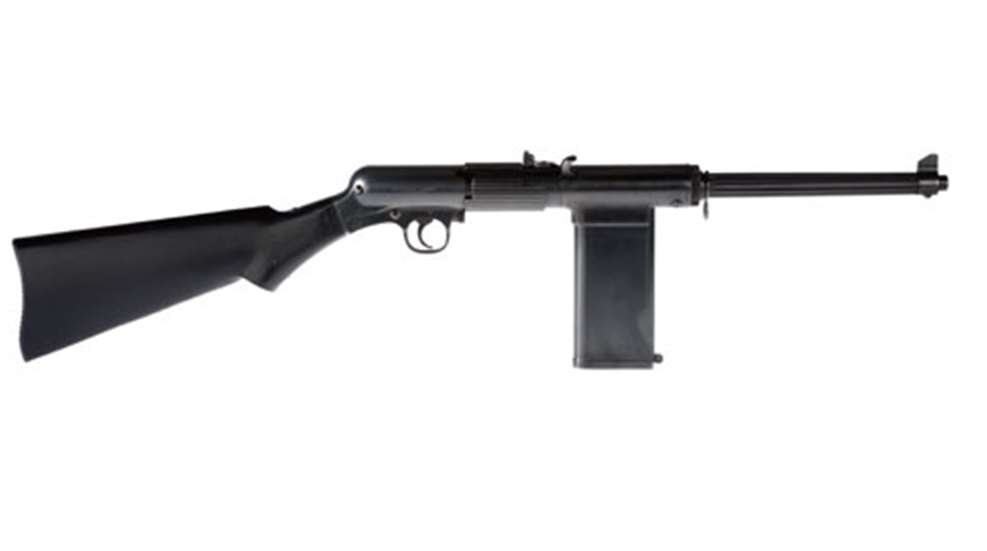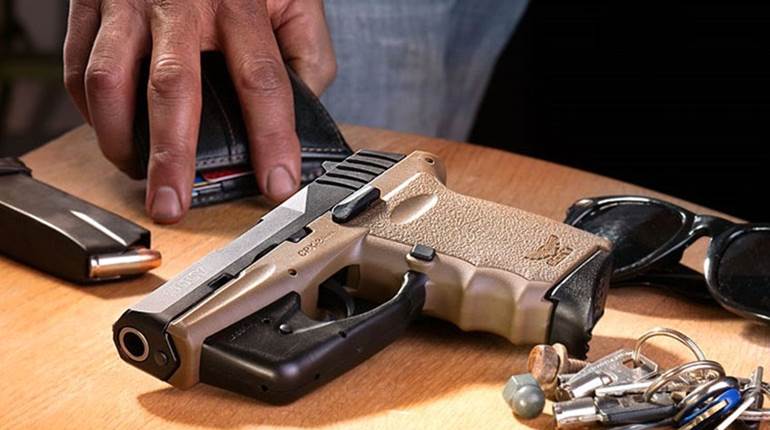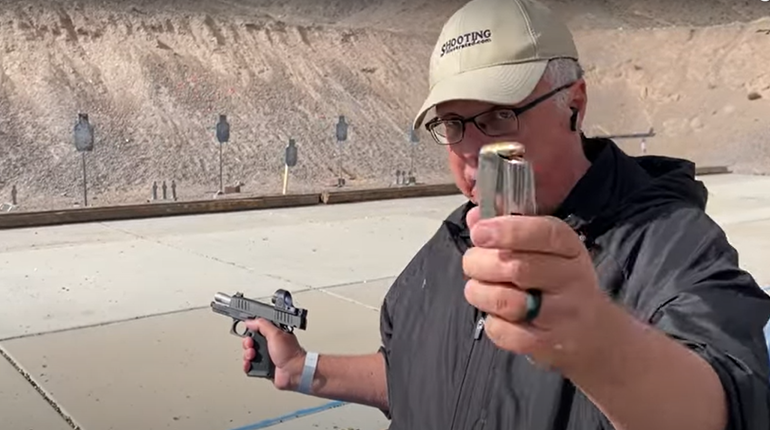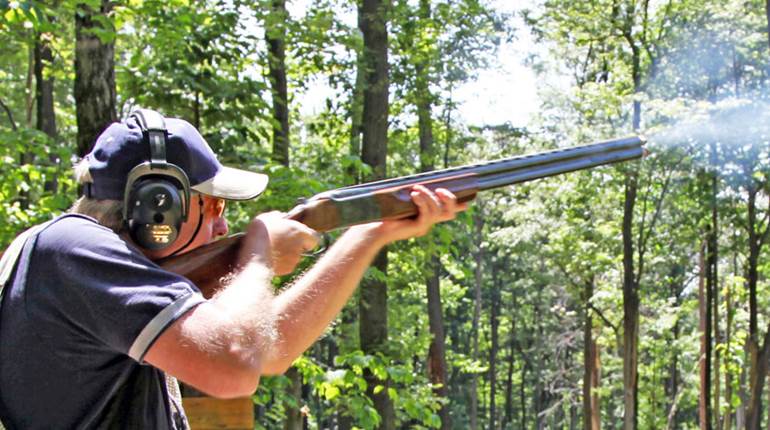
By the late 1930s, it was apparent to all but the most naïve or myopic that war in Europe was on the horizon, and prudent governments were making plans to acquire additional armaments for the pending conflict. When war finally erupted in 1939, the government of Great Britain was in the process of implementing the acquisition of all manner of military materiel, including small arms. One of the entities that Great Britain turned to as a secondary source of firearms for its soldiers was the well-known American company Smith & Wesson, which produced large numbers of revolvers under contract for the British government.
In early 1939, Great Britain consulted with Smith & Wesson regarding the development of a “light rifle” for potential use by that nation’s armed forces, and S&W’s chief designer, Edward S. Pomeroy, was tasked with the project. Pomeroy and his team designed a blowback-operated rifle chambered for the 9 mm Parabellum (Luger) cartridge. The initial patent was filed on June 28, 1939, and granted on Sept. 3, 1940. Smith & Wesson submitted design drawings and several prototype samples to the British government for approval. The design was deemed acceptable, and the British advanced $1 million to S&W in order to get the new carbine into production. The gun was designated the “Model 1940 Light Rifle.”
Most of the exterior metal surfaces of the Model 1940 were finely blued in typical S&W fashion, and it was fitted with a black plastic (Tenonite) stock. Rather than made of simple steel tubing, the receiver of the Model 1940 was of milled construction. Likewise, the 9 3/4-inch nickel-steel barrel featured 12 longitudinal flutes and was tapered; a contrast to the typical plain cylindrical barrel, which, frankly, would have had been more than satisfactory. All of those features resulted in a gun that was much more expensive and time-consuming to manufacture than necessary. The initial design utilized a bolt with an integral floating firing pin and hammer (superseded by a fixed firing pin in a later variant). The hammer was activated by camming against a projection in front of the receiver, which enabled the bolt to be fully seated before the gun could be fired. However, that kept the mechanism from utilizing the forward momentum of the bolt to counter some of the recoil from firing.
One of the more unusual, and recognizable, features of the Model 1940 was a combination grip and extended ejection port under the receiver, which housed a 20-round-capacity detachable-box magazine and a vertical tube through which the fired cartridge cases were ejected. The magazine was loaded from the front (not the bottom) of the housing. While not having fired cases flung around may have sounded like a positive attribute, the design of the extended ejection port prevented the shooter from easily observing the chamber to determine if a round was seated. It also made clearing malfunctions rather cumbersome—neither desirable features for a military arm.
Several early production rifles were sent to Great Britain for extensive testing at the Royal Small Arms Factory Enfield. Problems were immediately evident as the British 9 mm Luger cartridges used in the testing were significantly “hotter” than the American-made 9 mm cartridges used by S&W when the gun was under development. One of the more serious flaws was that the rear of the receiver was insufficiently sturdy to absorb the recoil of the bolt, which utilized a relatively light recoil spring. Tests indicated that the Light Rifle would not function reliably and could not pass a requisite 5,000-round endurance test with the British ammunition. Indeed, it was determined that the receiver could break after as few as a 1,000 rounds were fired. Further engineering work was ordered to correct the deficiency. Smith & Wesson engineers redesigned the gun to incorporate an “over sleeve” on the receiver intended to strengthen it at a critical stress point as well as provide for a safety that would securely lock the bolt. The later model was designated as the “Mark II” and the earlier version was, apparently retroactively, deemed the “Mark I.” The guns were shipped from the factory in wooden crates containing 10 guns each, a spanner wrench for removal of the barrel, as well as two 20-round magazines and one instruction manual per gun.
According to S&W’s archives, a total of 1,227 Model 1940 Light Rifles were manufactured, with 1,010 being sold to the British government. Smith had high hopes for the design and produced more receivers than called for under the British orders. Serial numbers from 1 to 2,200 have been reported, although, as stated, far fewer than 2,200 complete Model 1940 Light Rifles were actually manufactured.
Design flaws aside, the concept of a semi-automatic-only rifle that was 32-inches long, weighed more than 9 pounds (loaded), and fired a pistol cartridge hardly made for an optimum military arm for a variety of reasons. It lacked the rapid firepower of a submachine gun, did not possess the light weight (and better performance) of the M1 carbine, yet weighed almost as much as a M1 Garand rifle. It should come as no surprise that the British cancelled contracts after having received only 950 and did not issue the Model 1940 to its armed forces. Most guns delivered were of the Mark I variety with only about 200 Mark II variants being received by the British. It has been stated that the British government was due a partial refund of the advance payment for the Model 1940 Light Rifles, and S&W provided revolvers rather than cash to satisfy the obligation.
It is reported that an S&W Model 1940 rifle was tested by the U.S. Army Ordnance Dept. at Aberdeen Proving Ground but was rejected due to the fact it could only fire in semi-automatic and was chambered for the non-standard (for U.S. service) 9 mm Luger cartridge. It was suggested that S&W consider converting the design to permit full-automatic fire and resubmit it for testing, but there is no documentation to suggest that was ever done. Unconfirmed reports indicate that some of the early prototypes were capable of selective-fire operation but all of the production guns were semi-automatic only.
At the end of World War II, the Model 1940 rifles in the hands of the British were cut in half and dumped in the English Channel, except for five examples retained for display in various museums, including the Tower of London, Enfield and the British Military Museum. The remaining 217 unsold Model 1940 rifles were retained at the S&W factory. These guns remained in storage until 1974 when the company “rediscovered” the cache. Law enforcement dealer Bill Orr, owner of GT Distributors in Rossville, Ga., became aware of the crates of rifles in the factory basement and negotiated a purchase of the guns with S&W. It was first necessary to petition the Bureau of Alcohol, Tobacco and Firearms to classify the guns as “Curio and Relics” so as to exempt them from the restrictions of the National Firearms Act that would have otherwise been the case given their short (less than 16 inches) barrels. Approval from the BATF for C&R status was forthcoming and on March 30, 1975, S&W sold the 137 Mark I and 80 Mark II Model 1940 rifles to GT Distributors. Orr stated it took just over a year to resell the bulk of the guns to various civilian buyers.
In hindsight, the Model 1940 never stood a chance of becoming an effective military arm. While beautifully crafted in the typical S&W manner, it was over-engineered and had serious inherent design flaws. It is not clear why S&W green-lighted the development of such a flawed carbine or why the British were sufficiently impressed to invest a million dollars in the concept. It was undoubtedly one of those “It seemed like a good idea at the time” scenarios. Despite its flaws, Model 1940 Light Rifles are scarce and valued collectibles today.






































